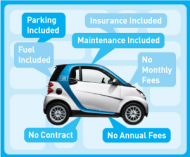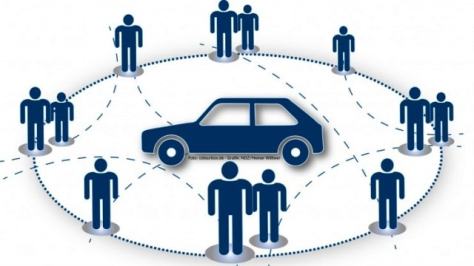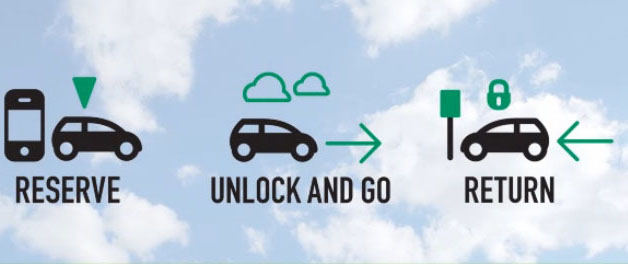By Will Maus
Edited by the Urban ABQ Communications and Outreach Committee
Editor’s note: At the Citywide Summit on Nov 18th, many amazing ideas for shaping the future of urban Albuquerque were suggested and discussed. One idea which emerged was a proposal for car sharing in Albuquerque. Below is a detailed 20 year plan for car sharing in Albuquerque. If you’re interested in this issue, click here to follow “NM Car Share” on Facebook!
Car Sharing in Albuquerque: Why Should We Care?
Conventional vehicle ownership as we know it is rather uneconomical. A car, truck, or SUV is the largest or second largest asset most people have, and it sits unused 96% of its life, depreciating, with an average annual cost in the high four figures. Combined with all the other alternative transportation modes (e.g. transit, ride sharing, biking, walking, etc.) car sharing offers a credible, economical substitute to private car ownership.

Car share members can forego all the pitfalls of car ownership while having convenient access to a broad fleet of vehicles. Discrete quarter-hour pricing leads to discrete use of vehicles, encouraging efficient use and saving members dollars they can spend locally, instead of sending to out-of-state carmakers and oil companies. Safe, well-maintained, insured vehicles displace older, less safe, less fuel-efficient, often uninsured vehicles- and at a rate of one shared car to perhaps a dozen private cars, free up hundreds of square feet of parking.

Car share vehicles get high levels of use and are more likely to be run while warm, therefore emitting less air pollution. Plus, car sharing can introduce extremely efficient vehicles in substantial numbers, often offering members the chance to grow familiar with new technology – as in hybrid and battery-power – without the risk of purchase.
Moving Car Sharing Forward in Albuquerque: What We’ve Done So Far

At the Citywide Summit, we floated the topic of developing car sharing to its fullest potential in our region. That became the basis for a collaborative push to evaluate the region’s institutional fleet needs and to see how combining them along with public use can create the critical mass of members needed for effective car sharing, while saving scarce budget dollars and offering a new level of accountability of asset use.
We had a meeting in early December 2017 attended by stakeholders from the City of Albuquerque, City Council, Bernalillo County, UNM, Mid- Region Council of Governments, and ABQ Ride. We heard from car sharing veterans in Boulder and Philadelphia about growing car sharing while saving millions of dollars of vehicle expense.
Click here to watch that meeting.
Car Sharing in Albuquerque: A 20 Year Plan
Although car sharing has existed in New Mexico for a number of years, its limited implementation has permitted it to reach only a fraction of its potential. National companies Zipcar and Enterprise Carshare have been here for several years but only have a total of six vehicles in Albuquerque.
We are motivated to maximize Albuquerque’s car sharing potential. This demands a grass roots, creative, collaborative, and sustained effort that these national for-profit companies likely will not pursue. This is our plan for NM Carshare:
Year 1:
- Partnerships are developed with every regional entity that has a vehicle fleet or serves as a mass destination for drivers. MRCOG helps research optimal Pod locations and vehicle types.
- Robust car sharing is established with a dozen vehicles. They are a mix of sedans, small SUVs, and small pickups. Some of the vehicles are used and have been donated by institutions.
- Initial Pod locations include UNM campuses, some A.R.T. and Rail Runner stations, public libraries, Kirtland Air Force Base, Fire/Police stations, and on-street spaces in dense neighborhoods.
Year 2:
- There are about fifty vehicles at about twenty five pods, including at most Rail Runner and A.R.T. stations.
- With relationships with MRCOG, ABQ Ride, NM DOT, and area Pueblos, work continues to weave the car sharing resource into the region’s overall mobility.
Year 3:
- There are about two hundred vehicles at about fifty Pods, including several Santa Fe locations. There are several wheelchair accessible vehicles strategically placed.
- The NM Carshare app can broadcast rideshare opportunities; automatically link members to form carpools.
- Virtually all new downtown and Uptown multi-unit residential construction features carsharing parking spaces.
- Outreach has begun to other NM Communities such as Las Cruces; Taos to help them consider car sharing.
- Member surveys show substantial drop in private car ownership potentially saving members thousands of dollars per year.
Year 5:
- NM Carshare is fielding about 300 vehicles in seventy-five Pods along the length of the Rail Runner line. It has its own facilities for vehicle maintenance and some repair.
- NM Carshare is making substantial improvements in local air quality with members retiring their older, dirtier vehicles in favor of far fewer and cleaner carshare vehicles.
- The fleet is broadened to include specialty and vocational vehicles like cherry pickers, stake body trucks, and fifteen passenger vans.
- NM Carshare has developed a link between donors, volunteers, and mobility justice. Expensive paratransit trips are being eliminated by our enabling good samaritan members to instead drive those customers, volunteering their time and driving ability while NM Carshare provides the vehicle. NM Carshare offers a donation link to help subsidize these trips.
Year 20:
- There are about 700 vehicles in the NM Carshare fleet, most of which are a single, battery powered model for economy of scale but which also includes specialty vehicles strategically located around the region. Virtually every neighborhood, employment center, major transit stop, retirement community, and pueblo has Pods.
- The introduction of autonomous vehicles has compelled vehicle inspections in New Mexico, even of legacy non-autonomous vehicles so that they are more mechanically predictable in their interactions with an autonomous system. This has sent the most decrepit vehicles to scrap while raising the minimum operating cost of a private vehicle and propelling more drivers into carsharing.
- Carsharing is second nature and has grown along with transit (an additional North-South BRT route to the Sunport, etc.), bikesharing, biking in general, handicapped sidewalk access, and ride sharing (Uber/Lyft). The confluence of mature alternative modes to driving has substantially changed the region’s mobility habits; fewer people own cars.
- Uptown, the Mile Hi District, North 4th Street, and several other neighborhoods have developed their own own walkable TOD cores and supports several pods.
- New development in the region (the failure of Santolina is a distant memory) is dense and tied in to transit, even outside of downtown.
- As they are no longer needed for parking vehicles people are renovating their garages into living space; increasing value of houses an average of $50K (click here to see the RMI study) and therefore increasing property taxes.
- Carsharing adds to the economic resiliency of the region by decreasing the flow of money to out of state auto manufacturers and oil companies.
And Into the Autonomous Future:
- NM Carshare brand can carry on with autonomous vehicles; it would be the hometown favorite as autonomous services begin to be rolled out.
- There will always be a role for a nonprofit in the space: ensuring mobility justice and coordinating vehicle use with area entities.
How would you grow carsharing, especially in far-flung, low-density places? Is there a role for carsharing in the South Valley, or North Valley? Click here to join NM Carshare’s Facebook page and contribute your thoughts.


